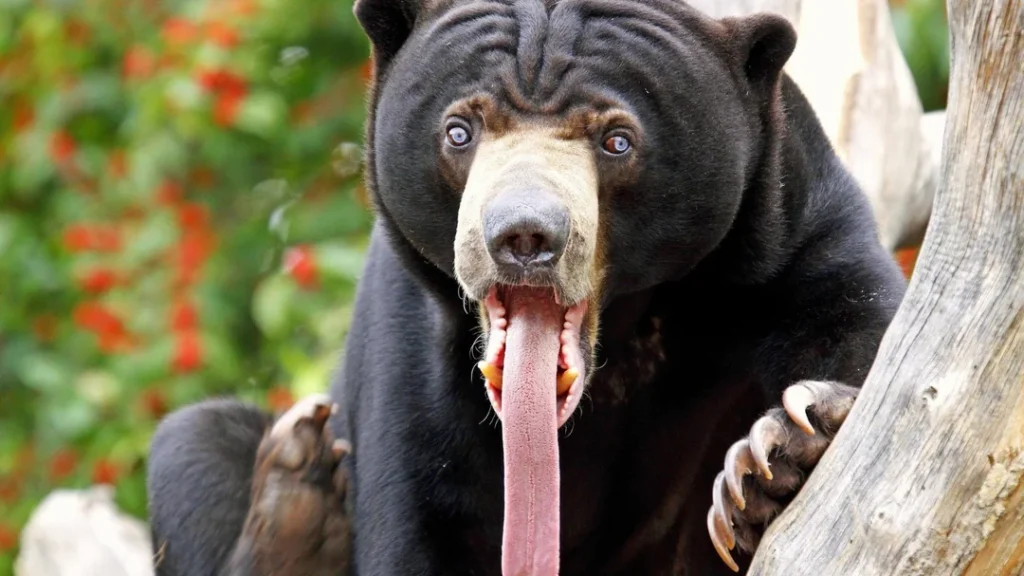
The honey bear, also known as the kinkajou, is a fascinating creature found in the lush rainforests of Central and South America. Despite its name, the honey bear is not a bear at all but a member of the Procyonidae family, which includes raccoons. This nocturnal, arboreal mammal has captured the curiosity of nature enthusiasts for its unique characteristics and vital role in the rainforest ecosystem. In this detailed guide, we’ll dive into everything you need to know about the honey bear, its habitat, diet, and why it’s called nature’s sweetest icon.
Understanding the Honey Bear
What Exactly Is a Honey Bear?
A honey bear, or kinkajou, is a small mammal with golden-brown fur, a prehensile tail, and a long tongue that it uses to extract nectar and honey from flowers. Known for its playful nature, the honey bear is an arboreal creature that spends most of its life in trees.
- Honey bear characteristics include its sharp claws for climbing, large eyes adapted for night vision, and a highly flexible tail for gripping branches.
- Despite its nickname, the honey bear is not a bear but shares traits with other tree-dwelling mammals, making it a unique species in its ecological niche.
Is a Honey Bear the Same as a Kinkajou?
Yes, the terms “honey bear” and “kinkajou” refer to the same animal. The nickname “honey bear” stems from its love of honey and nectar. While it may resemble a monkey or bear, it is more closely related to raccoons.
- Use of honey-seeking behaviors explains why locals often associate the animal with sweetness and trees.
The Habitat and Role of Honey Bears in Nature
Where Do Honey Bears Live?
Honey bears are native to the dense rainforests of Central and South America, ranging from Mexico to Brazil. They prefer tropical and subtropical climates where they can thrive in forest canopies.
- Tropical rainforest animals, honey bears depend on the ecosystem’s biodiversity for survival.
- They occupy the upper layers of the forest, living in hollow trees and avoiding predators by staying high above the ground.
How Do Honey Bears Survive in Rainforests?
Survival in the rainforest requires several adaptations unique to the honey bear:
- Diet: Their diet includes fruits, nectar, honey, and occasionally insects, which are abundant in rainforests.
- Arboreal Lifestyle: As tree-dwelling animals, their prehensile tail provides balance and mobility, allowing them to navigate the forest canopy.
- Nocturnal Habits: Honey bears are active at night, reducing competition for food and minimizing exposure to predators.
These traits highlight the honey bear’s crucial role in maintaining the balance of rainforest ecosystems, making them essential biodiversity contributors.
Diet and Behavior of Honey Bears
What Does a Honey Bear Eat?
The honey bear’s diet consists primarily of sweet, nutrient-rich foods:
- Honey and nectar, giving them their name and role as pollinators.
- Fruits such as bananas, mangoes, and guavas.
- Occasionally, they consume insects or small animals to supplement their nutrition.
Their specialized tongue, up to five inches long, allows them to extract nectar from deep within flowers. This makes them important nectar feeders who aid in pollination, benefiting the plants and animals in their habitat.
Honey Bear Behavior and Traits
Honey bears are known for their curious and playful nature. They are primarily nocturnal, spending their nights foraging for food and exploring their surroundings.
- As small rainforest mammals, their agility and climbing skills are unparalleled, allowing them to move effortlessly through the treetops.
- Their honey-seeking behaviors are not just adorable but also critical for spreading pollen, highlighting their ecological importance.
Why Are Honey Bears Called Nature’s Sweetest Icon?
The Symbolism of Honey Bears
Honey bears represent sweetness and the delicate balance of nature. Their preference for honey and nectar symbolizes their connection to rainforest flora. As icons of biodiversity, they remind us of the importance of preserving natural habitats.
- Honey bear symbolism reflects their role as pollinators and seed dispersers, essential for the health of tropical ecosystems.
Fun Facts About Honey Bears
- Honey bears can rotate their ankles 180 degrees, enabling them to climb down trees headfirst.
- Despite their love for honey, they rarely disturb bees and instead find natural sources of nectar.
- Honey bears are sometimes called “night monkeys” due to their nocturnal habits and playful demeanor.
The Importance of Honey Bears in Conservation
Are Honey Bears Endangered?
While honey bears are not classified as endangered, they face increasing threats from deforestation, habitat loss, and illegal wildlife trade. Conservation efforts focus on protecting their natural habitats and raising awareness of their ecological significance.
- Protecting honey bear habitats ensures the survival of other rainforest species that rely on the same ecosystem.
Honey Bears and Rainforest Biodiversity
Honey bears play a pivotal role in supporting rainforest biodiversity:
- As pollinators, they help plants reproduce by spreading pollen.
- Their seed-dispersing habits aid in forest regeneration, ensuring the growth of new plants.
By preserving honey bears, we also safeguard the broader ecosystem, benefiting countless species.
How Can We Protect Honey Bears?
Protecting honey bears starts with conserving their rainforest habitats. Here’s how you can contribute:
- Support organizations dedicated to rainforest conservation.
- Advocate for sustainable practices that reduce deforestation.
- Educate others about the importance of honey bears and their ecosystems.
Small actions can make a big difference in ensuring these nature’s sweetest icons continue to thrive.
Conclusion
Honey bears, also known as kinkajous, are truly nature’s sweetest icons, playing a vital role in maintaining the balance of rainforest ecosystems. Their unique behaviors, such as pollinating plants and dispersing seeds, highlight their ecological significance. Despite their playful and gentle nature, honey bears face increasing threats due to habitat destruction and deforestation. Protecting these fascinating creatures not only preserves their existence but also safeguards the biodiversity of the tropical rainforests they call home. By raising awareness, supporting conservation efforts, and advocating for sustainable practices, we can ensure that honey bears continue to thrive and contribute to the health of our planet for generations to come.
FAQs
What is a honey bear?
A honey bear, also known as a kinkajou, is a tropical mammal native to rainforests. Despite its name, it is not a bear but is famous for its love of honey and nectar.
Where do honey bears live?
Honey bears are found in the dense rainforests of Central and South America, where they live in tree canopies and feed on nectar and fruits.
What do honey bears eat?
Honey bears primarily eat nectar, honey, and fruits but may also consume insects and small animals. Their diet makes them important pollinators.
Why are honey bears called nature’s sweetest icon?
Honey bears are called nature’s sweetest icon due to their love of honey and their role in pollination and seed dispersal, contributing to rainforest health.
How can we protect honey bears?
We can protect honey bears by supporting conservation efforts, reducing deforestation, and spreading awareness about their ecological significance.






